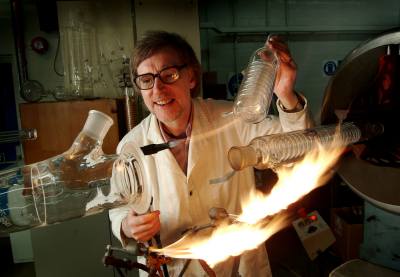|
Glassblowing At Dounreay,
Caithness In January 1957, the construction of the analytical chemistry laboratories known as D1200, were completed and this gave the opportunity to relocate the glassblowing workshop to within this area. Unfortunately, the layout of the workshop did not provide easy natural ventilation nor were the windows designed to keep the team of glassblowers cool. Keith had by now been joined by fellow glassblower Ron Redford and later Tom Abbott, Jim Kennedy and George Gough. It was hot work! All except George left Keith in less than two years, some to further their glassblower career in alternative establishments while others left the profession altogether. Scientific glassblowing is a specialised skill with less than twenty people in Scotland being employed in this capacity. Dounreay’s current scientific glassblower Ian Pearson has been with UKAEA since 1981, having taken over from Keith when he left for Exeter University. Keith has now retired, although works freelance on several glassblowing projects.
Ian is the current Chairman of the British Society of Scientific Glassblowers, an organisation founded in 1960 by glassblowers at UKAEA Harwell, Aldermaston and a group in the Birmingham area. The membership list of the BSSG in 1964 shows eleven glassblowers, including Keith, employed by the UKAEA, at sites throughout Britain. Messrs Begbie, Fussey, Henson, Price and Edwards were based at Aldermaston; Messers Hickson and Quadir at Harewell. At Amersham there were Messers Hartfield and Killick, while Joe Allen was based at Winirth. At the inaugural meeting of the BSSG on 20th November 1960, Patrick Begbie represented UKAEA. In 1959 the glassblowing department at Dounreay was joined by Derek Rodwell and Norman Dunnigham, both from Jobling’s of Sunderland, (makers of the classic Pyrex casserole dishes and measuring jugs). Bill Cowie from Aberdeen also joined the department in the 1960’s, which had by now moved to a new location at the east end of the laboratories where it still exists today. There have been several other staff members in this department, notably Forsthye Oag and Jim Rosie. During the 1950’s and 60’s the glassblowing requests focused on constructing glassware for remote handling in “caves”, as well as very small volumetric work for analytical purposes. This changed in the 1970’s and 80’s when there was an increase in research and development in chemical engineering. The glassware required included large diameter glass pipe work with specialised glass apparatus joined inside. Keith Goodchild left the UKAEA to join Exeter University in 1980. Many others have experienced the “hot flames” that glow to keep the glassblowing skills alive over the last 50 years. Some have arrived as students, pupils and staff searching for alternative employment. All have left with the knowledge of the importance of manual dexterity. The challenges that the glassblowers faced during this time involved sealing glass to metal, glass to ceramics, shaping glass to designs specified by engineers and scientists, (usually drawn on the back of the proverbial envelope!) in sizes ranging from fractions of a millimetre to vessels large enough for a person to climb through! The casual observer can be forgiven for thinking that the turnover of glassblowers in the 1950’s and 60’s demonstrated that there was a ready supply of qualified staff. Quite the opposite was true. From records held at the National Archives in Kew, London, and openly available to the public, an intriguing story of UKAEA’s glassblowers is told where many differences of opinion were expressed as to how to recruit, train and pay them. Although this was taking place at Harwell, it had consequences for other sites such as Dounreay. Correspondence dated 1st June 1949 states: “It is very important, therefore, that we secure an improvement in pay for glassblowers, since otherwise it is very doubtful if we shall be bale to maintain the present complement.” Thankfully, the skills required to become a successful glassblowers were recognised as early as 1950 when, according to a document dated 20th June, it states: “Only the few born with the aptitude can ever become masters of the art”. The document continues: “The conditions to be met are, therefore, quite outside the requirements of any Civil Service grading! Looking further back at court records from the 18th Century, the following is reported: “convicted at the Surrey Assizes at Kingston-upon-Thames, on 24 March 1784, for soliciting and endeavouring to persuade Charles King, a glass maker/blower of Gravel-Lane Glass-house, to go out of the kingdom to work at his trade in France (against 23 Geo.2. cap 13; and others).” The verdict? “Initial sentence: £500 fine and 1 year imprisonment. Recommendation: no mercy.” One wonders if the same approach would be made for glassblowers exporting their skills outwith Caithness? |
